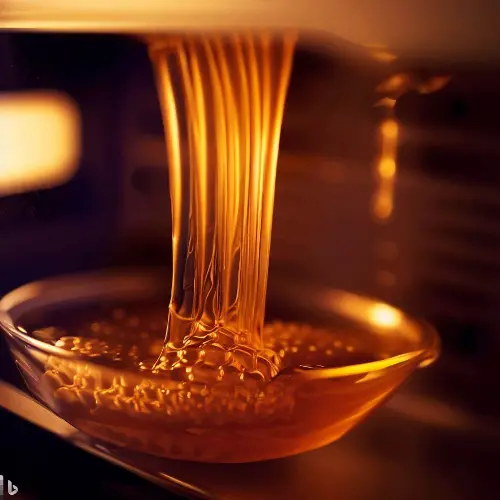Thekitchenkits.online is an Amazon Associate and earns from qualifying purchases made through affiliate links on our site at no extra cost to you. This supports our efforts to bring you valuable kitchen-related content.
Table of Contents
Can You Microwave Honey in a Plastic Container?
Honey is a delicious natural sweetener that is made by bees from the nectar of flowers. However, when stored for a long time, honey can crystallize and harden, making it difficult to use.
A common question is whether you can microwave honey in a plastic container to re-liquefy it.
Can You Microwave Honey in Plastic?
Microwaving honey in plastic is generally not recommended. Plastic containers can melt or release chemicals when heated in the microwave. A microwave’s high temperatures and heating pattern can cause plastic to warp, melt, or leach chemicals into foods.
Most food safety organizations, including the FDA, advise against heating any food in plastic containers in the microwave. This is because heat can cause chemicals in the plastic, like bisphenol A (BPA) and phthalates, to leak into the food. Over time, ingesting these chemicals may have harmful health effects.
Instead, it’s safest to microwave honey in a glass or ceramic container that is labeled “microwave safe.” Glass jars and containers won’t melt or leach chemicals when heated.
Tips for Softening Crystallized Honey
If your honey has crystallized, there are a few safe methods you can use to decrystallize it without using the microwave:
- Place the jar of honey in a bowl of warm water. Replace the water every few minutes so it stays warm. The indirect heat will slowly liquefy the honey.
- Set the honey jar on a sunny windowsill or another warm spot. The radiant heat can help gradually soften the crystallized honey.
- Use a portable electric heating pad set to low. Wrap it around the honey bottle to gently warm and loosen the crystals.
- Place the container in a pan of water on the stove. Heat the water over low heat until the honey melts again. Be careful not to boil or overheat the honey.
- Add the honey to hot tea, coffee, or baked goods recipes. The heat from the liquids or oven will reliquefy it.
- Stir or whip the crystallized honey vigorously with a spoon. This can break up some of the sugar crystals.
- Decrystallize small amounts of thickened honey by stirring in a few drops of warm water. The water molecules will help break apart the sugar structure.
Safe Microwavable Containers for Honey
If you do need to microwave honey, use a microwave-safe glass jar or bowl. Here are some safe containers to reheat crystallized honey:
Glass Jars
Glass jars are ideal for microwaving honey. Common food jars made of glass do not contain chemicals that can leach into foods during heating. Look for ones labeled “microwave safe.”
Mason jars or old honey jars work well too. The glass allows the honey to be heated evenly. Be sure to remove the metal lid first since metal cannot go in the microwave.
Ceramic Bowls
Ceramic bowls and mugs made for microwave use are also perfectly safe for warming honey. Avoid ceramic with metallic paint or detailing which can spark.
Make sure your ceramic dish is smoothed glazed to prevent the honey from absorbing into the pores. Transfer the honey to a squeezable bottle afterward.
Microwave-Safe Plastic
Some plastic containers are specially manufactured to be microwaveable without leaching chemicals. Look for the microwave-safe symbol on bottles and containers before using.
However, honey is acidic, so prolonged contact with even microwave-safe plastic can cause chemicals to leach. Use plastic only for briefly reheating honey, not for long-term storage.
How to Microwave Honey
When microwaving honey in a safe glass or ceramic container, follow these tips:
- Use a small microwave-safe bowl or jar. Larger containers can overheat honey unevenly.
- Microwave the honey in short 10-30-second bursts. Stir between each burst to distribute the heat.
- Stop heating when the honey becomes thin and pourable. Overheating can destroy enzymes and nutrients in honey.
- Let the honey cool slightly before handling. Heated honey can become very hot.
- Transfer the liquefied honey into a squeezable bottle for easy use.
- Clean out the heating container well after use since heated honey is more difficult to wash off.
Storing Honey After Microwaving
After microwaving, it’s best not to store honey long-term in the plastic bottle it was heated in. To retain the honey’s quality and avoid chemical contamination:
- Pour the reheated honey into a glass jar or squeezable bottle for storage.
- Cover tightly and store in a cool, dark place like a cupboard. Honey doesn’t need refrigeration.
- If the honey re-crystallizes, you can gently reheat it again following safe methods. Crystallization does not affect the honey’s safety.
- Avoid storing honey in the refrigerator long-term. The cold temperature causes faster crystallization.
- Discard any burnt or caramelized honey. Burnt sugar contains health-harming hydroxymethylfurfural.
By following these precautions, you can safely keep your honey smooth and ready to use!
FAQ
Why does honey crystallize?
Honey naturally contains a high concentration of sugars that tend to crystallize over time. Changes in temperature, moisture, and what flowers the bees gather nectar from can cause honey to solidify and turn opaque in the jar.
Is it safe to eat crystallized honey?
Yes, crystallized or creamed honey is still perfectly safe to eat! The crystallization process does not affect the honey’s quality or nutrition. Simply liquefy solidified honey gently by warming it before use. The flavor and health benefits remain the same.
Can you microwave honey in a plastic bottle?
It’s not recommended. Heating honey in a plastic bottle in the microwave can potentially cause chemicals to leach into the honey. Use microwave-safe glass or ceramic containers instead when warming crystallized honey.
Does microwaving destroy nutrients and enzymes in honey?
Excessive heat from a microwave can damage some of the beneficial enzymes and antioxidants in raw honey. Microwave honey in very short intervals and do not overheat to help retain its beneficial properties.
How do you soften honey without a microwave?
To decrystallize honey without a microwave, try warming the jar in hot water, sitting it in sunlight, using a heating pad, or whipping it vigorously. Adding warm water and stirring can also help dissolve sugar crystals.
Conclusion
Microwaving honey in plastic is not recommended since the high heat can cause chemicals to leach into the honey. For best results and safety, always use microwave-safe glass or ceramic containers. Gently heat the crystallized honey in short intervals, watching carefully to avoid overheating.
Other effective methods like hot water baths or sitting honey in warm spots can also soften it without using a microwave. Storing reheated honey in a cool, dry place will help prevent rapid re-crystallization. With some simple precautions, you can safely enjoy smooth, liquid honey anytime!

I’m Ian Welkins, a seasoned professional in the kitchen industry. My passion now drives me to provide invaluable insights into the world of top-notch kitchen products. With years of hands-on experience, I’m your go-to source for culinary excellence.


